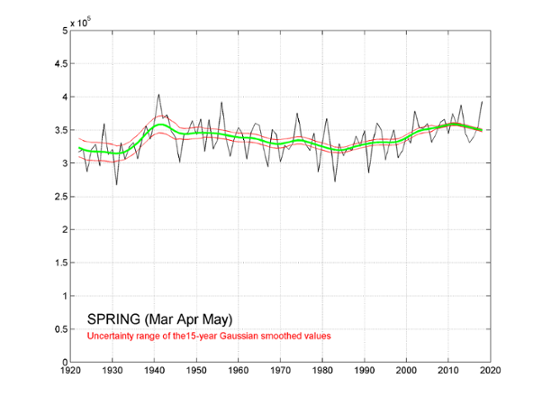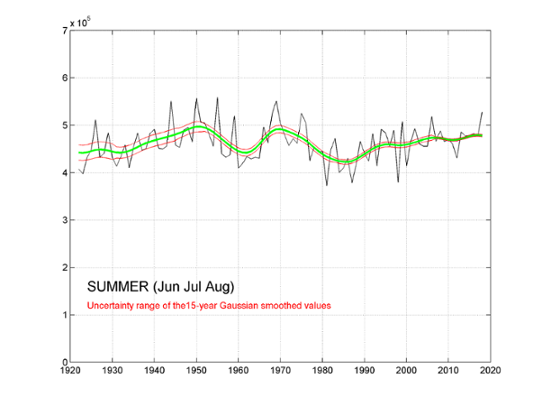Introduction
In 1922 monitoring of global irradiation (i.e. solar radiation on a horizontal surface) started in Stockholm, Sweden. It is now one of the worlds longest series of global radiation.
Material and methods
The instruments have changed over the years and so have the site. Unfortunately, much of the earliest data found in the archive is only daily values and sometimes even monthly values. The original raw observations are lost and thus it is hard to control and eventually change questionable data.
From late 1945 hourly data was evaluated and this made analysis and eventual corrections much easier. Details can be found in Josefsson (2019).
The quality was strongly improved as a new network using automatic station technique was introduced in 1983. An upgrade in 2007 has continued on the path of improving the data quality.
Results
The oldest part of the series (1922-1930) is very uncertain in particular for the winter half year. Low sun and effects from rime, snow and rain seems to give a lot of strange values.
It might be a little better quality from 1931 to 1945 at least for the summer half year.
The so called global dimming can be seen i.e. slightly higher values in 1950- to 1970-ties followed by a decrease into the 1980-ties. Many sites around the world recorded a decrease in solar radiation.
After that there has been a recovery of the solar radiation duration. We are now more or less back to a relatively higher level. The same features can be observed for the sunshine duration.




In general there is no significant trend over the whole period 1922-2018. For shorter periods one can find both up- and down-ward variations on decadal scales.
Uncertainty analysis
In general regarding the uncertainty of the data one can distinguish three periods. The first 30 years with old types of instruments and data aquisition systems and now lost raw data and meta information often shows a large scatter around plausible model calculated values. The documentation found in archives is sparse or non-existent making eventual corrections a guesswork.
In the early 1950-ties newer instruments and data acquisition systems were introduced. The data were evaluated on an hourly basis and when these data are available it makes it possible to apply more precise corrections for various instrument errors. But still, severe and sometimes unknown errors in data are evident.
The automization and introduction of new instrumentation starting 1st January 1983 proved to produce data of much higher quality than before.
The uncertainty analysis presented in this section is based on information and methodology described in Cook (2002) and ISO-GUM (1993). For data back to late 1945 it has been applied to daily values. The calculations are made using an Excel-spreadsheet following the worked example of Cook (2002). Many details are open for discussion as they are rough estimates. However, from the spreadsheets one can easily see which uncertainty components that dominates for each instrument type and that others without doubt are of minor importance for the overall result.
Based on the daily results estimates have been done for the individual monthly uncertainty. In general the quality is poor during the winter and much better in the summer half-year.
In brief, the oldest part (1922-1945) of the global radiation series is highly uncertain in particular during the winter. Then follows a period (1945-1956) with slightly improved quality but still high uncertainty.
The following years 1957 up to 1982 are relatively better than the older periods. Still, one should be cautious in the winter time where data is of low quality. But, from 1983 and forwards the quality is significantly better even in the winter time.
Download monthly global radiation
format in a read.me file (1 kB, txt)"
Download daily global radiation
download daily values (4,3 MB, txt)"
format in a read.me file (2 kB, txt)
Note: The daily data set is not complete. Existing daily values can be downloaded here.
Using any of these data we are glad if you refer to: Source: SMHI and Josefsson (2019).
If you are interested in hourly data of global radiation (globalstrålning) you can download later years from "Öppna data" (in Swedish soon in English).
References
Cook R.R. (2002). Assessment of uncertainties of measurement for calibration & testing laboratories, second edition. ISBN 0-909307-46-6.
ISO (1993). Guide to the Expression of Uncertainty in Measurement (GUM), First edition, ISO,1993.
Josefsson W. (1987). Solstrålningen i Sverige. Tids- och rumsfördelning. Byggforskningsrådet Rapport R112:1987. ISBN 91-540-4824-9.
Josefsson W, (2019). Long-term global radiation in Stockholm, 1922-2018. SMHI, Meteorology, No 165. ISSN: 0283-7730 .